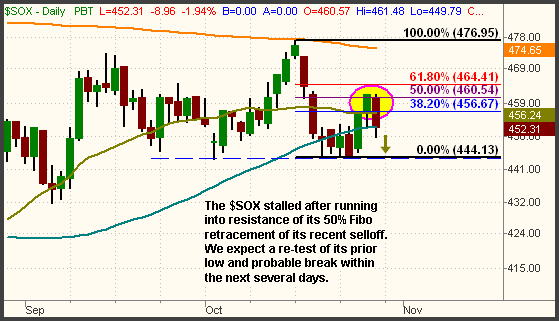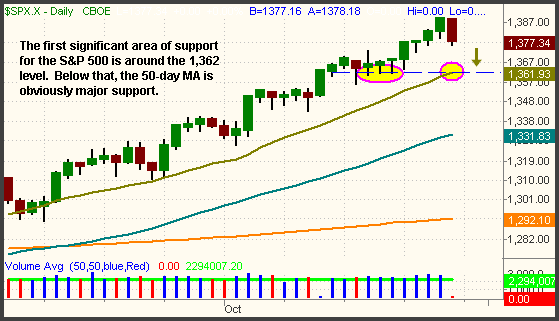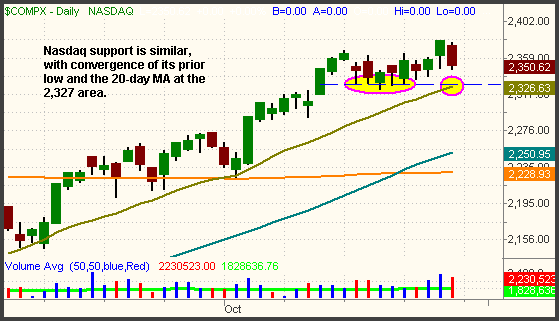The stock market concluded last week with a well-deserved rest, as each of the major indices corrected firmly off their highs. After starting the session in the red, stocks attempted to recover throughout the morning, but a wave of selling in the early afternoon caused the market to reverse back down and subsequently break its morning lows. The Nasdaq Composite and S&P 500 fell 1.2% and 0.9% respectively, while the Dow Jones Industrial Average fared better with its 0.6% loss. The S&P Midcap 400 slid 1.2% and the small-cap Russell 2000 closed 1.3% lower. All of the major indices finished near their intraday lows, which is likely to put a bit of pressure on today's open.
The bright spot of last Friday's action was that the losses occurred on lighter volume. Given the substantial losses, one might have expected to see a surge in turnover, but that wasn't the case. Total volume in the NYSE declined by 10%, while volume in the Nasdaq was 7% lighter than the previous day's level. Because stocks fell on lower volume, we know that the correction was more the result of the buyers drying up as opposed to heavy institutional selling. Since more than half of the market's average daily volume is driven by institutional trading, it's important to constantly be aware of what is happening "beneath the hood" of the market, then trade in the same direction as the institutional players.
The culprit of last Friday's afternoon selloff was a rapid reversal in the Semiconductor Index ($SOX), which began to lead the Nasdaq lower just after 1:00 pm. Ever since running into overhead resistance of its 200-day moving average on October 16, the $SOX has been showing relative weakness to the market. Because the $SOX often leads the Nasdaq, which in turn tends to lead the S&P, we've been extensively analyzing the action in the index over the past several weeks. On a technical level, last Friday's poor performance in the $SOX was significant, so let's once again take a look:

On October 19, the $SOX index fell to key support of its prior low from October 3, then clung to that level through October 24. On October 25, the $SOX popped back above its 50-day MA, but we pointed out that a retracement of more than 50% of its loss was necessary in order for the index to have a good chance of rallying back to its high. Not surprisingly, the $SOX tested resistance of its 50% Fibonacci retracement level on October 26, but that resistance is the reason the $SOX fell the following day, last Friday. If the index fails to quickly rally back above its October 26 high, the new "lower high" in the $SOX will likely cause it to break down to new lows on its next move down. Per an intraday e-mail alert to subscribers in the afternoon, we initiated a new short position in the Semiconductor HOLDR (SMH). Assuming the relative weakness continues, SMH will soon break its prior low.
Since Friday was the first losing day in the S&P 500 in the past eight sessions, it could easily fall much lower and still be trading above the lower channel support of its primary uptrend. With a short-term correction apparently starting, let's take a look at where the S&P and Nasdaq are likely to find support that could provide a buying opportunity. We'll start with the well-diversified S&P 500 index:

The dashed horizontal line on the chart above marks the first area of substantial price support on the S&P 500. Support is found in the 1,362 area through to convergence of the 20-day moving average with the range of the lows from two weeks ago. At the very least, we expect to see a correction down to this level. Upon doing so, we will re-assess its price action in order to determine whether or not the index is likely to make another leg lower. If not, we may "dip a toe in the water" by looking to buy the ETFs with the most relative strength. But if the S&P fails to hold at 1,362 support, the 50-day moving average, presently at 1,331, will act as even greater support to catch it. Next, take a look at the Nasdaq Composite:

Although not picture on the daily chart above, last Friday's slide in the Nasdaq came only day after the index managed to close at a fresh multi-year high. If the index in unable to recover back above last week's high, we will have the start of a classic "double top" chart formation. As for support, the Nasdaq has a similar pattern to the S&P. Its 20-day moving average converges with last week's low, which should provide support at the 2,326 area. Below that, the 50-day moving average resides all the way down at 2,250. As always, keep a close eye on the daily price action of the $SOX in order to predict the Nasdaq's next move.
Finally, don't forget about gold and, more specifically, the StreetTRACKS Gold Trust (GLD). It closed last Friday above its 50-day moving average for the first time since early September and is only a hair away from breaking out above its 200-day MA as well. Recall that such a breakout will also result in GLD setting a "higher high" and moving above its five-month downtrend line. In the pre-market, the spot gold commodity is presently trading higher by $5 per ounce. If it holds, this will translate into an opening gap that puts GLD just above its 200-day MA. We remain long our partial position from the October 25 entry, and still plan to buy more shares on confirmation of the breakout.
Deron Wagner is the Founder and Head Trader of both Morpheus Capital LP, a U.S. hedge fund, and Morpheus Trading Group, a trader education firm launched in 2001 that provides daily technical analysis of the leading ETFs and stocks. For a free trial to the full version of The Wagner Daily or to learn about Wagner's other services, visit MorpheusTrading.com or send an e-mail to deron@morpheustrading.com.